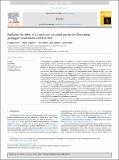| dc.contributor.author | Yan, Longxu | |
| dc.contributor.author | Duarte, Fábio | |
| dc.contributor.author | Wang, De | |
| dc.contributor.author | Zheng, Siqi | |
| dc.date.accessioned | 2020-09-01T19:49:17Z | |
| dc.date.available | 2020-09-01T19:49:17Z | |
| dc.date.issued | 2019-08 | |
| dc.date.submitted | 2018-11 | |
| dc.identifier.issn | 0264-2751 | |
| dc.identifier.uri | https://hdl.handle.net/1721.1/126881 | |
| dc.description.abstract | Understanding the complex impact of air pollution is crucial to assessing exposure risk and defining public health policies in China. However, the evidence and hence knowledge of how urban activity responds to air pollution are limited. In this paper, we propose to use geotagged check-in records on Weibo, a Tweeter-like platform, to systematically investigate the effect of air pollution on urban activity. Based on panel models, we found clear evidence that such effect exists and varies between pollutants, visitors and residents, and different activity types. Typically, SO2 has the largest impact, followed by PM2.5, NO2, and PM10; local citizens' activities are more susceptible than visitors; leisure-related activity has a sensitivity at least twofold higher than work-related activities. Additionally, we tested hypotheses about the heterogeneous effect. We confirmed the role of Income and air quality, showing that people who live in richer and more polluted cities are more likely to experience the effects of air pollution. Specifically, people who live in a more polluted city with 100 unit increments in AvgAQI show on average the same sensitivity as those who live in a less polluted city and earn about 20.3 thousand yuan more in average Income. This reveals new insights about environmental injustice in China. By presenting a portrait of the spatial heterogeneity, we argued that environmental injustice in terms of air pollution is not just about the difference in exposure risk measured based on population distribution, rather the measurement should also consider the disparity derived from urban activity. Secondly, new injustice may arise in underdeveloped areas where manufacture industry is transferred to but people barely take avoidance behavior. Finally, the map also reveals the general neglect of the detrimental effect of light air pollution, which we speculate is partly due to China's comparatively low standard in governmental regulations. We believe our finding contributes significantly to exposure risk assessment and environmental justice debates. Hence it highlights the necessity and urgency of public healthy polices that spread the health consequence of air pollution, especially in the underdeveloped region. | en_US |
| dc.language.iso | en | |
| dc.publisher | Elsevier BV | en_US |
| dc.relation.isversionof | http://dx.doi.org/10.1016/j.cities.2018.11.011 | en_US |
| dc.rights | Creative Commons Attribution-NonCommercial-NoDerivs License | en_US |
| dc.rights.uri | http://creativecommons.org/licenses/by-nc-nd/4.0/ | en_US |
| dc.source | Other repository | en_US |
| dc.title | Exploring the effect of air pollution on social activity in China using geotagged social media check-in data | en_US |
| dc.type | Article | en_US |
| dc.identifier.citation | Yan, Longxu et al. "Exploring the effect of air pollution on social activity in China using geotagged social media check-in data." Cities 91 (August 2019): 116-125 © 2018 Elsevier Ltd | en_US |
| dc.contributor.department | Massachusetts Institute of Technology. SENSEable City Laboratory | en_US |
| dc.contributor.department | Massachusetts Institute of Technology. Department of Urban Studies and Planning | en_US |
| dc.relation.journal | Cities | en_US |
| dc.eprint.version | Author's final manuscript | en_US |
| dc.type.uri | http://purl.org/eprint/type/JournalArticle | en_US |
| eprint.status | http://purl.org/eprint/status/PeerReviewed | en_US |
| dc.date.updated | 2020-08-31T14:48:43Z | |
| dspace.date.submission | 2020-08-31T14:48:45Z | |
| mit.journal.volume | 91 | en_US |
| mit.license | PUBLISHER_CC | |
| mit.metadata.status | Complete | |
